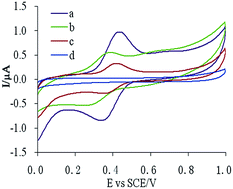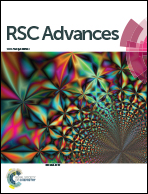A simple and sensitive sensor based on a molecularly imprinted polymer-modified carbon paste electrode for the determination of curcumin in foods
Abstract
A highly sensitive and selective molecularly imprinted polymer-modified carbon paste electrode (MIP-CPE) was designed. The curcumin molecularly imprinted polymer (CUR-MIP) was prepared by thermally induced precipitation polymerization, using curcumin (CUR) as the template molecule, methacrylic acid (MAA) as the functional monomer, 2,2′-azodiisobutyronitrile (AIBN) as the initiator, and ethylene glycol dimethacrylate (EDGMA) as the cross-linker. The modified electrode was prepared by mixing the polymer, graphite powder, and paraffin oil in specific proportions. The electrochemical behaviour of CUR on this electrode was studied, and a method for direct CUR determination using this electrode was established. The results showed that CUR exhibited a distinct oxidation peak (Epa) at 0.434 V (vs. SCE) in the mixed phosphate buffer solution (PBS) at pH 3.06. The optimum addition ratio of the polymer in the modified electrode was 20%, and the peak current (Ipa) was 4.5-fold higher than that of the bare CPE. The Ipa showed a good linear relationship with concentration in the range 0.1–50 μM, and the detection limit was 10.1 nM. The method was applied to determine CUR contents in food, giving recovery rates of 90.77–105.7%.



 Please wait while we load your content...
Please wait while we load your content...